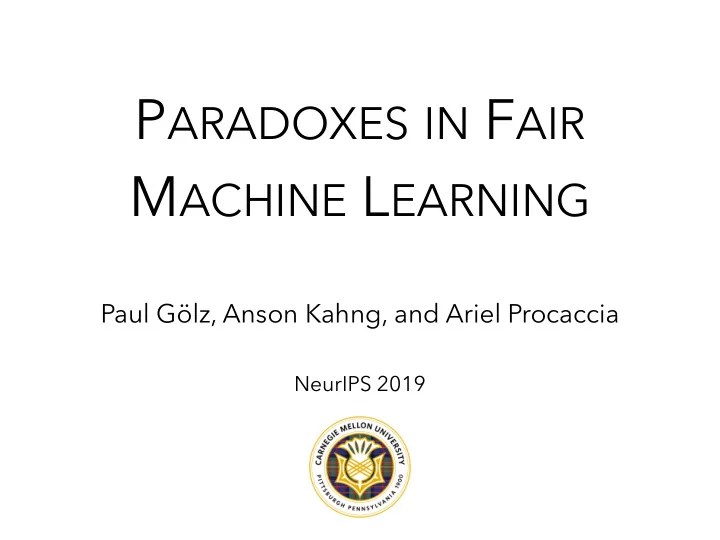

P ARADOXES IN F AIR M ACHINE L EARNING Paul Gölz, Anson Kahng, and Ariel Procaccia NeurIPS 2019
R ESEARCH Q UESTION “Fairness in machine learning vs. fairness in fair division” What is the relationship between statistical notions of fairness (in particular, equalized odds) and axioms of fair division (in particular, the axioms of resource monotonicity, population monotonicity, and consistency)?
C LASSIFICATION WITH C ARDINALITY C ONSTRAINTS Classification problem with a fixed budget of available resources to distribute Loans Applicants Goal : train a classifier to maximize efficiency (fraction of loans that will be repaid)
C LASSIFICATION WITH C ARDINALITY C ONSTRAINTS Loans Applicants Two groups: hats vs. no hats Goal : Distribute loans to applicants in order to minimize the default rate. Metric : efficiency
C LASSIFICATION WITH C ARDINALITY C ONSTRAINTS Loans Applicants Calibrated classifier : If the classifier labels a set of people with probability � , then a � p p fraction of them are positive instances.
C LASSIFICATION WITH C ARDINALITY C ONSTRAINTS Loans Applicants Low High Probability of repaying loan
C LASSIFICATION WITH C ARDINALITY C ONSTRAINTS Allocation In this setting, the optimal allocation rule awards loans to the most qualified applicants. But what about fairness between Low High groups? Probability of repaying loan
F AIRNESS C ONCEPTS S TATISTICAL F AIRNESS F AIR D IVISION A XIOMS Resource monotonicity Equalized odds Population monotonicity Demographic parity Consistency How compatible are these notions of fairness? How much does efficiency suffer if we have to satisfy both equalized odds and various fair division axioms?
F AIRNESS C ONCEPTS S TATISTICAL F AIRNESS F AIR D IVISION A XIOMS Resource monotonicity Equalized odds Population monotonicity Demographic parity Consistency Research question (rephrased): How much does efficiency suffer if we must satisfy both equalized odds and various fair division axioms?
̂ ̂ S TATISTICAL F AIRNESS Equalized Odds (EO) : “A predictor � satisfies equalized odds with respect to a Y protected attribute � and outcome � if � and � are A Y Y A independent conditional on � ” (Hardt et al. 2016) Y � Pr( ̂ Y = 1 | A = 1, Y = 1) = Pr( ̂ Y = 1 | A = 0, Y = 1) � Pr( ̂ Y = 1 | A = 1, Y = 0) = Pr( ̂ Y = 1 | A = 0, Y = 0) “True positive and false positive rates are equal across groups”
̂ ̂ S TATISTICAL F AIRNESS Equalized Odds (EO) : “A predictor � satisfies equalized odds with respect to a Y protected attribute � and outcome � if � and � are A Y Y A independent conditional on � ” (Hardt et al. 2016) Y Pr( ̂ � Y = 1 | A = 1, Y = 1) = Pr( ̂ Y = 1 | A = 0, Y = 1) Pr( ̂ � Y = 1 | A = 1, Y = 0) = Pr( ̂ Y = 1 | A = 0, Y = 0) “True positive and false positive rates are equal across groups”
F AIR D IVISION A XIOMS Resource monotonicity : “Adding more resources makes everyone better off” Population monotonicity : “Adding more people makes everyone worse off” Think of these axioms as preclusions of paradoxes.
R ESOURCE M ONOTONICITY “Adding more resources makes everyone weakly better off” Budget Allocations
P OPULATION M ONOTONICITY “Adding more people makes everyone weakly worse off” Budget Allocations
R ESULTS 1. In the cardinality-constrained model, we characterize the optimal allocation rule that satisfies equalized odds 2. Equalized odds and resource monotonicity are achievable with no loss to optimal EO efficiency 3. Any rule that satisfies equalized odds and population monotonicity cannot achieve a constant-factor approximation to optimal EO efficiency 4. The only rule that satisfies equalized odds and consistency is uniformly random allocation
Recommend
More recommend